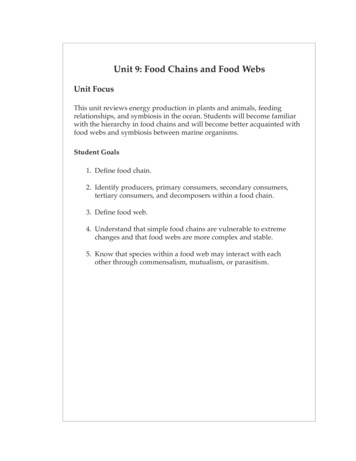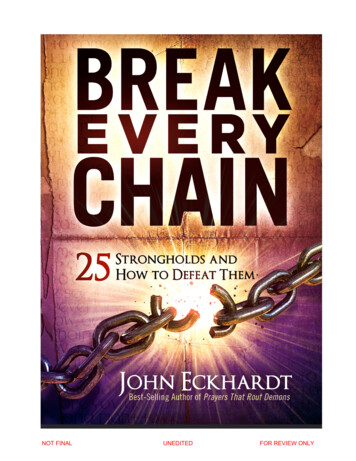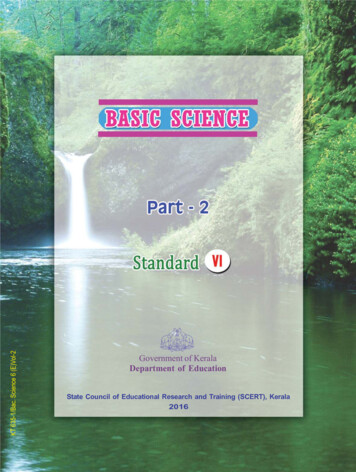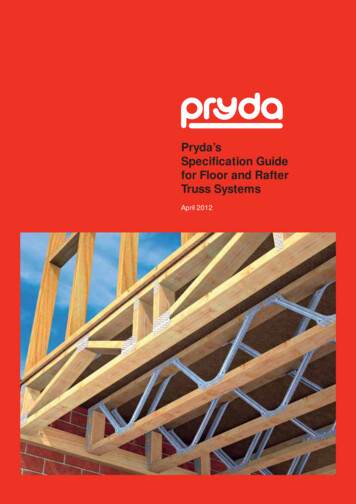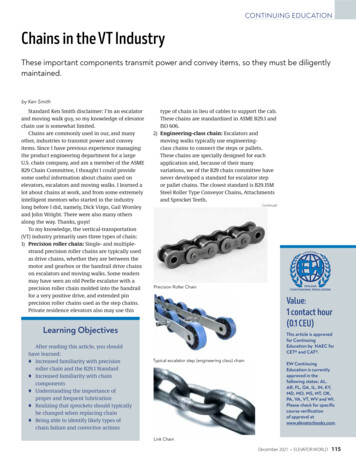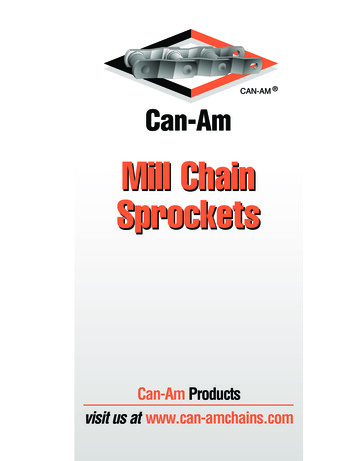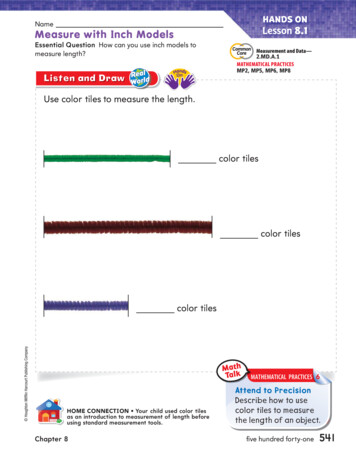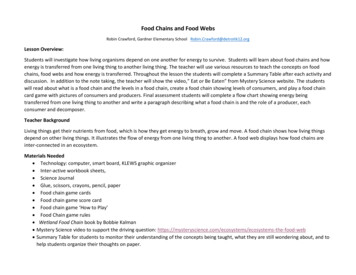
Transcription
Food Chains and Food WebsRobin Crawford, Gardner Elementary School Robin.Crawford@detroitk12.orgLesson Overview:Students will investigate how living organisms depend on one another for energy to survive. Students will learn about food chains and howenergy is transferred from one living thing to another living thing. The teacher will use various resources to teach the concepts on foodchains, food webs and how energy is transferred. Throughout the lesson the students will complete a Summary Table after each activity anddiscussion. In addition to the note taking, the teacher will show the video,” Eat or Be Eaten” from Mystery Science website. The studentswill read about what is a food chain and the levels in a food chain, create a food chain showing levels of consumers, and play a food chaincard game with pictures of consumers and producers. Final assessment students will complete a flow chart showing energy beingtransferred from one living thing to another and write a paragraph describing what a food chain is and the role of a producer, eachconsumer and decomposer.Teacher BackgroundLiving things get their nutrients from food, which is how they get energy to breath, grow and move. A food chain shows how living thingsdepend on other living things. It illustrates the flow of energy from one living thing to another. A food web displays how food chains areinter-connected in an ecosystem.Materials Needed Technology: computer, smart board, KLEWS graphic organizer Inter-active workbook sheets, Science Journal Glue, scissors, crayons, pencil, paper Food chain game cards Food chain game score card Food chain game ‘How to Play’ Food Chain game rules Wetland Food Chain book by Bobbie Kalman Mystery Science video to support the driving question: he-food-web Summary Table for students to monitor their understanding of the concepts being taught, what they are still wondering about, and tohelp students organize their thoughts on paper.
Driving question board to guide class or small group discussions and investigations. (The driving question contextualizes the contentof a project-based unit and provides students the opportunity to connect it to their personal experiences. A driving question is a rich,open-ended question that uses everyday language to make connections with students' authentic interests and curiosities.)ReferencesMystery of Science: he-food-webKalman, Bobbie. Wetland Food Chain. Crabtree Publishing Co. www.crabtreebooks.com5th grade Inter-active science workbook teacher pay teacher (attached to the lesson plan)Target Grade/Subject: 5th grade; Life ScienceSetting: classroomAdvance preparation: pre-cut food chain cards.Learning Objectives:Students will be able to: explain what a food chain is, describe how energy is transferred, create several food chains and show how they can be inter-connected. describe how they’d fit into a food chain in a model or in writing.Michigan Science StandardsMatter and Energy in Organisms and Ecosystems5-PS3-1 Use models to describe that energy in animals’ food (used for body repair, growth, motion, and to maintain body warmth) was onceenergy from the sun.5-LS2-1 Develop a model to describe the movement of matter among plants, animals, and the environment.SEP: Science & Engineering PracticesDeveloping and using models, obtaining, evaluating and communicating informationEngaging in argument from evidenceDCI:PS3-EnergyLS2: Ecosystems: Interactions, Energy, Dynamics
CCC: Cross-Cutting Concepts4. Systems and System Models5. Energy and Mater: Flows, cycles and conservationDriving Question: How do living things depend on other living things for food?Engage: Day 11. TW pass out the Summary Table graphic organizers (students will use this to record their responses, thoughts and wonders on this sheetafter each activity)2. TW place the driving question on a large board (poster board). SW write their responses on sticky notes that will be posted on thedriving question board.3. TW will use the responses to guide the class discussions. SW add some of the responses to their Summary table.4. TW read pages 8-11 from the book, Wetland Food Chains. TW introduce the vocabulary words, nutrients, producer, consumer,herbivores, omnivores carnivores, primary, secondary and tertiary consumer to the class as he/she reads the book.5. TW write the definition for each word on the board.6. SW copy the vocabulary and draw a picture or write an example of each.Explore: Day 27. TW review over the driving question board and the sticky notes of questions and ideas.8. TW show the video, Eat or be Eaten”, from Mystery of Science. TW use the prompts for short discussions.9. After the video, SW talk about what they learned about food chains and use evidence from the video to support their statement (recordtheir responses on the Summary table).10. TW have the students explain why the hawk chose to live in the city instead of a grassy plain.11. TW use the following questions to facilitate the discussion about what they observed in the video and how it relates to the drivingquestion: What drove the hawks to live in the city? What needs to be present for an animal to live in an area? What evidence can you use from the video to support your statement?
Explain: Day 2Students will complete another row of their summary table: activity, what they observed, what they figured out and how is it related to thedriving question. Students will share out what they learned.Elaborate: Day 3 “Food Chain Game”1. TW review over the driving question board, and the students will share what they know about what a living thing needs to survive.5-minutes2. TW have the students review over the vocabulary from day 1. 5 minutes3. TW pass out the materials for the food chain game and read over the rules of the game. Students will work in groups of four.4. Students will create food chains using the game cards and record their models on their game sheet. SW create a food web using thedifferent food chains. 20 minutes(Support and clarifying details: TW have the students share the different chains they created. Teacher will have the students label eachconsumer in their food chain.)Evaluate: Day 4Informative Evaluation: Students will cut and paste pre-printed animals and plants onto construction paper. Students will label eachpart of the food chain correctly: producer, energy, and primary, secondary, tertiary consumer.Formative Evaluation: Students will explain what a food chain is in their own words, create a food chain and model how different foodchains connect to make a food web.Teacher will assess the student’s food chain explanation to make sure that they mention transfer of energy, and that animals eat otheranimals for nourishment and energy. Students should start each food chain with a producer, and include three consumers.Vocabulary: producer, consumer, primary, secondary, tertiary, food chain, food web (see p. 8-11 in Wetland Food Chain book)
Name:Summary TableWhat did we do?What did we observe?What patterns did wenotice?What have we figured out?How does this relate to the?
RulesTHE GOALSOF THE GAME:Web of Life Mystery 1 Make as many food chains as you can.Make the chains as long as you can.(Longer chains get bonus points!)HOW SCORING WORKS:HOW STEALING WORKS:You’ll get 1 point for everycard in a food chain: 3 cards 3 pointsIf your chain is 4 cards orlonger, you get an extra2 bonus points:4 cards 2 bonus points 6 pointsTIP: REARRANGEYOUR CHAINSYou CAN’T steal on the first round.Starting in the second round, youcan choose a card from the centerstack or you can STEAL a cardfrom another player if you can usethat stolen card to make a chainright away.You CAN’T steal a card that isalready in a player’s food chain.TIP: THINK CAREFULLYRead the cardscarefully. The Cricketcard says crickets eatleaves. The Oak Treehas leaves. Thatmeans the cricket caneat the oak tree!You can rearrange your food chains whenever youwant. Take them apart and put them together in differentways. Can you figure out ways to get longer chains?
Rules for Eat or Be Eaten Food Web GameYou need: 2 to 4 players A deck of Eat or Be Eaten cards A table where player can lay out their cards as they form food chainsGoal of the Game: Make as many cards as you can into food chains AND make thosefood chains as long as you can.How to play1. Shuffle the deck and pile the cards in the center, face down.2. On the first round, players take turns picking a card from the pile & reading thecard aloud.3. On each subsequent turn, a player has a choice. They can choose a card fromthe pile or steal a card from another player.Important Note: Once a card is linked in a food chain, it can’t be stolen. Putting cardsin a food chain protects them.4. The game continues until all the cards are used or you run out of class time.5. At the end of the game, each player tallies their score using their Eat or Be Eatenscorecard.Rules for Scoring You get 1 point for every card in a food chain. Food chains of four or more cards get 2 bonus points.Note: At Mystery Science, we encourage players to reason from the descriptions on the cards.For example, the cricket eats dead leaves and the oak tree produces leaves. Though the oaktree card doesn’t say that there are dead leaves under the oak tree, a player may contend thatthere are leaves under the tree to provide food for the cricket and make a food chain.Advanced Play: Making Food WebsPlayers may realize that some of their food chains could be connected to form a network ofinterlocking chains — that is, a food web.If your group realizes this and if you have time, ask them to see how many chains they canconnect in a food web. It is possible to arrange the entire deck of cards so that every card isconnected to the others by a predator or prey relationship.
Score CardName:1. WRITE DOWN YOUR LONGEST CHAIN:eats eats eatseats eats . Yum!2. ADD UP YOUR SCORE!Use the back if you run out of room:Chain 1:Write down how many cards are in the chain:If there are 4 or more, add 2 bonus points:Chain 2:Write down how many cards are in the chain:If there are 4 or more, add 2 bonus points:Chain 3:Write down how many cards are in the chain:If there are 4 or more, add 2 bonus points:Chain 4:Write down how many cards are in the chain:If there are 4 or more, add 2 bonus points:Chain 5:Write down how many cards are in the chain:If there are 4 or more, add 2 bonus points:TOTAL points points
3. TW pass out the materials for the food chain game and read over the rules of the game. Students will work in groups of four. 4. Students will create food chains using the game cards and record their models on their game sheet. SW create a food web using the different food chains.
